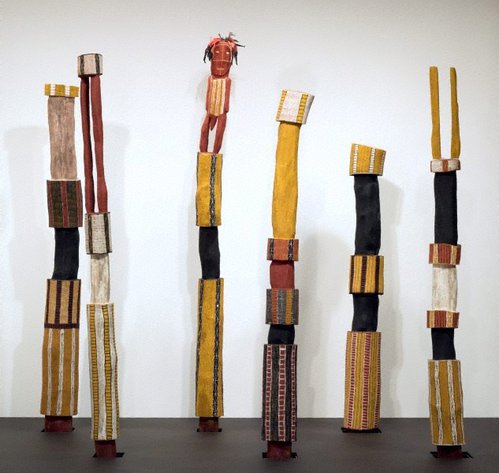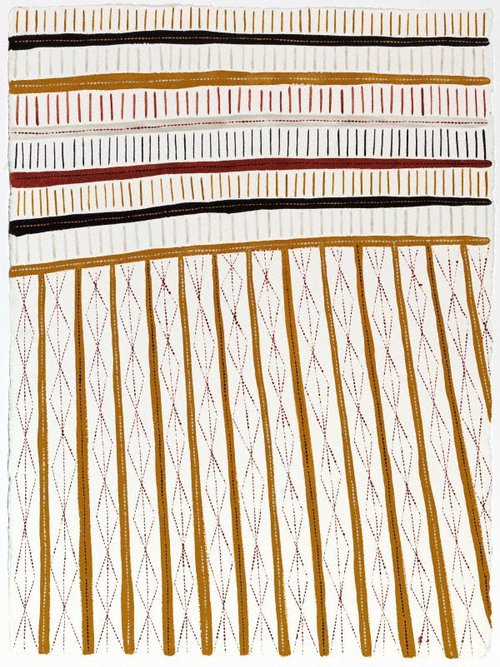Title
Ningarimi awarra Wujuwurri (History of Tiwi)
2023
Artist
-
Details
- Place where the work was made
-
Milikapiti (Snake Bay)
→
Melville Island
→
Northern Territory
→
Australia
- Date
- 2023
- Media category
- Sculpture
- Materials used
- ironwood, natural pigments, feathers, beeswax
- Dimensions
-
display dimensions variable
:
a - Purukupali, 82.5 x 14 x 17 cm, irreg.
b - Japarra, 46 x 14 x 15 cm, irreg.
c - Waiyai, 65 x 13 x 15 cm, irreg.
d - Jinani, 46 x 14 x 15 cm, irreg.
- Signature & date
Not signed. Not dated.
- Credit
- Purchased with funds provided by the Aboriginal Art Collection Benefactors 2023
- Location
- Not on display
- Accession number
- 299.2023.a-d
- Copyright
- © Pedro Wonaeamirri, courtesy Jilamara Arts/Copyright Agency
- Artist information
-
Pedro Wonaeamirri
Works in the collection
- Share
-
-
About
The following text is drawn from Pedro Wonaeamirri’s, ‘Pukumani; Letting the world know’ in Tuckson, Art Gallery of New South Wales, Sydney 2018, and Pedro Wonaeamirri, One Foot on the Ground, One Foot in the Water, exhibition catalogue, La Trobe Art
Institute, 2020.“Old Tiwi songline. Purukuparli calling out telling the world: ‘now my son is dead, now we all
have to follow him’.A long time ago the story was told to me of a great man, Purukuparli, and his wife, Waiyai.
They had a baby son, Jinani. On the other side of the bush camp there was Taparra, the
moon man, Purukuparli’s brother. One day at the camp on the eastern side of Melville
Island, Waiyai said to Purukuparli, ‘Can you look after our baby son? I will go out into the
bush and look for food for our son,’ and she left the little baby boy under a big shady tree.
When she set off in the bush looking for food there was Taparra, the moon man. Taparra
saw Waiyai. Then, instead of looking for food, Waiyai went to Taparra and they made love.
The sun moved, the shade moved and the little baby got hot, burnt by the sun. The baby
was crying, then he died. Purukuparli went back to the camp and saw Jinani dead. He
grabbed his son and called out to Waiyai, ‘Your son, your son!’ Purukuparli knew something
was wrong. Then, Taparra approached and said, ‘I will take him up for three days and I will
bring him back to life again.’ Purukuparli said, ‘Now that my son is dead, you all have to die,
you all follow my son.’ Waiyai went down to the creek, crying. She was saying that she was
guilty of something. Instead of looking for food she went and made love. That was wrong.
Then Purukuparli said, ‘My son is dead. Now I will have a Pukumani ceremony for my son.’
Before birds were birds, birds were human. There was pelican, the white egret, the owl, the
black cockatoo and the white cockatoo. They heard Purukuparli and said, ‘We will give you
feathers to make headbands, armbands, false beards.’ Then Purukuparli had the ceremony
on the eastern side of Melville Island. That was a long time ago.
That story was told by my ancestors, my close family.”This story of Purukuparli, his wife and son, is important to Tiwi life and culture. It teaches
lessons about life and is also the beginning of our ceremonial culture. Since the time when
Purukuparli danced his dead son into the sea at Yimpinari, the Tiwi people have come
together for the Pukumani ceremony – to sing, dance and farewell the spirit of our family so
they can be at rest back on Country. Pukumani ceremony is a grieving ceremony, but it is
also a celebration of life. Every dance has a song. The song and dance are how you connect
to the land and the spirit of the deceased person. To let go and say goodbye, see you next
time on your Country.



